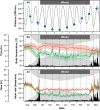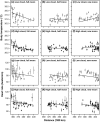Impacts of "supermoon" events on the physiology of a wild bird
- PMID: 31380065
- PMCID: PMC6662397
- DOI: 10.1002/ece3.5311
Impacts of "supermoon" events on the physiology of a wild bird
Abstract
The position of the Moon in relation to the Earth and the Sun gives rise to several predictable cycles, and natural changes in nighttime light intensity are known to cause alterations to physiological processes and behaviors in many animals. The limited research undertaken to date on the physiological responses of animals to the lunar illumination has exclusively focused on the synodic lunar cycle (full moon to full moon, or moon phase) but the moon's orbit-its distance from the Earth-may also be relevant. Every month, the moon moves from apogee, its most distant point from Earth-and then to perigee, its closest point to Earth. Here, we studied wild barnacle geese (Branta leucopsis) to investigate the influence of multiple interacting lunar cycles on the physiology of diurnally active animals. Our study, which uses biologging technology to continually monitor body temperature and heart rate for an entire annual cycle, asks whether there is evidence for a physiological response to natural cycles in lunar brightness in wild birds, particularly "supermoon" phenomena, where perigee coincides with a full moon. There was a three-way interaction between lunar phase, lunar distance, and cloud cover as predictors of nighttime mean body temperature, such that body temperature was highest on clear nights when the full moon coincided with perigee moon. Our study is the first to report the physiological responses of wild birds to "supermoon" events; the wild geese responded to the combination of two independent lunar cycles, by significantly increasing their body temperature at night. That wild birds respond to natural fluctuations in nighttime ambient light levels support the documented responses of many species to anthropogenic sources of artificial light, that birds seem unable to override. As most biological systems are arguably organized foremost by light, this suggests that any interactions between lunar cycles and local weather conditions could have significant impacts on the energy budgets of birds.
Keywords: circadian; energy expenditure; lunar cycles; supermoon.
Conflict of interest statement
None declared.
Figures




Similar articles
-
Cloud cover amplifies the sleep-suppressing effect of artificial light at night in geese.Environ Pollut. 2021 Jan 7;273:116444. doi: 10.1016/j.envpol.2021.116444. Online ahead of print. Environ Pollut. 2021. PMID: 33453700
-
Lunar Phase Modulates Circadian Gene Expression Cycles in the Broadcast Spawning Coral Acropora millepora.Biol Bull. 2016 Apr;230(2):130-42. doi: 10.1086/BBLv230n2p130. Biol Bull. 2016. PMID: 27132135
-
Blooming rhythms of cactus Cereus peruvianus with nocturnal peak at full moon during seasons of prolonged daytime photoperiod.Chronobiol Int. 2016;33(4):419-30. doi: 10.3109/07420528.2016.1157082. Epub 2016 Mar 30. Chronobiol Int. 2016. PMID: 27030087
-
The lunar cycle: effects on human and animal behavior and physiology.Postepy Hig Med Dosw (Online). 2006;60:1-7. Postepy Hig Med Dosw (Online). 2006. PMID: 16407788 Review.
-
The Still Dark Side of the Moon: Molecular Mechanisms of Lunar-Controlled Rhythms and Clocks.J Mol Biol. 2020 May 29;432(12):3525-3546. doi: 10.1016/j.jmb.2020.03.009. Epub 2020 Mar 19. J Mol Biol. 2020. PMID: 32198116 Free PMC article. Review.
Cited by
-
Women temporarily synchronize their menstrual cycles with the luminance and gravimetric cycles of the Moon.Sci Adv. 2021 Jan 27;7(5):eabe1358. doi: 10.1126/sciadv.abe1358. Print 2021 Jan. Sci Adv. 2021. PMID: 33571128 Free PMC article.
-
Artificial light at night suppresses the day-night cardiovascular variability: evidence from humans and rats.Pflugers Arch. 2024 Mar;476(3):295-306. doi: 10.1007/s00424-023-02901-0. Epub 2024 Jan 4. Pflugers Arch. 2024. PMID: 38177874 Free PMC article. Review.
-
Seasonal variation in sleep homeostasis in migratory geese: a rebound of NREM sleep following sleep deprivation in summer but not in winter.Sleep. 2021 Apr 9;44(4):zsaa244. doi: 10.1093/sleep/zsaa244. Sleep. 2021. PMID: 33220057 Free PMC article.
-
Optimal sampling interval for characterisation of the circadian rhythm of body temperature in homeothermic animals using periodogram and cosinor analysis.Ecol Evol. 2024 Apr 9;14(4):e11243. doi: 10.1002/ece3.11243. eCollection 2024 Apr. Ecol Evol. 2024. PMID: 38601852 Free PMC article.
References
-
- Bevan, R. M. , Woakes, A. J. , Butler, P. J. , & Croxall, J. P. (1995). Heart rate and oxygen consumption of exercising gentoo penguins. Physiological Zoology, 68, 855–877. 10.1086/physzool.68.5.30163935 - DOI
-
- Bryant, D. M. , & Westerterp, K. R. (1983). Short‐term variability in energy turnover by breeding house martins Delichon urbica: A study using doubly‐labelled water (D2 18O). Journal of Animal Ecology, 52, 525–543. 10.2307/4570 - DOI
-
- Butler, P. J. , Green, J. A. , Boyd, I. L. , & Speakman, J. R. P. J. (2004). Measuring metabolic rate in the field: The pros and cons of the doubly labeled water and heart rate methods. Functional Ecology, 18, 168–183.
LinkOut - more resources
Full Text Sources
Research Materials

